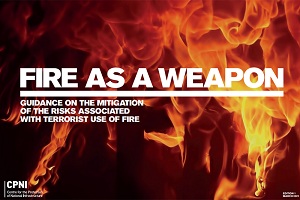The UK’s Centre for the Protection of National Infrastructure (CPNI) has released new guidance on Fire as a Weapon (FAW), where terrorists or attackers may attempt to deliberately use fire to harm people, property, or both.
The guidance document has been developed in collaboration with the Home Office, National Counter Terrorism Security Officer (NaCTSO) and the National Fire Chiefs Council (NFCC). It is designed to highlight the mitigation of the risks posed by those conducting attacks that combine the use of fire with other methods.
It is aimed at any professionals involved in the protection of Critical National Infrastructure (CNI) sites, sensitive facilities and crowded places – in particular it is said to be most useful for Building Managers; Physical Security Managers; Security Control Room Managers; The ‘responsible person’ for fire safety; and Security Risk Assessors. The guidance covers:
• An understanding of the FAW threat
• Key hazards created by FAW attacks
• How current fire related regulations address the issues
• Steps to be considering to reduce the risk posed from FAW attacks
CPNI highlights that a well planned and executed FAW attack is likely to have a devastating effect, which often come in forms such as petrol bombs, flammable liquid being poured and then ignited, or grenades/similar devices being thrown that start or cause a fire.
Several examples of FAW attacks have taken place over the last few years, emphasising the need for security professionals to be aware of the risks and hazards involved. In March 2019, a lone and heavily armed terrorist attacked two mosques in Christchurch, New Zealand, where they intended to augment a firearms attack by setting light to two five litre petrol cans.
Only two months earlier, in Nairobi, Kenya, a group of terrorists targeted a hotel complex by throwing grenades at cars in a parking lot to set fire to the vehicles. And, in June 2017 in London, three terrorists carrying out a vehicle as a weapon (VAW) and knife attack were equipped with petrol bombs – though these were not used in the incident and their intention remains unknown.








